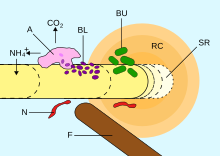Rhizosphere

A : bacteriophage amoeba
BL : energy-limited bacteria
BU : non-energy- limited bacteria
RC : root-derived carbon
SR : detached cells of the rhizodermis
F : fungal hyphae
N : nematode
The term rhizosphere was coined in 1904 by the bacteriologist Lorenz Hiltner and describes the space in the soil that is directly influenced by a living root .
The influences can be physical, chemical and biological in nature. In general, a zone up to 40 mm around the root is called the rhizosphere. This area is of particular interest in terms of soil ecology , as it is where the soil, plants and living beings (especially microorganisms of the microfauna ) interact .
The rhizosphere is strongly influenced by substances released by the plant, so-called exudates . It also differs from the surrounding soil in that it has lower nutrient and oxygen concentrations , since both are consumed by the plant. The pH value can also differ from the surrounding soil by several units.
In particular, due to the exudates released and the better pH value conditions, the rhizosphere is characterized by a mostly significantly higher density of organisms (5 to 50 times); this phenomenon is referred to as the rhizosphere effect. The rhizosphere is an important habitat for a wide variety of biocenoses , which mainly consist of nematodes , fungi (including mycorrhiza ) and other microorganisms . The higher number of organisms leads on the one hand to competition between the roots and soil organisms , but on the other hand they can also make additional nutrients available for the plant (e.g. rhizobia or other bioeffectors ).
The rhizosphere connects seamlessly to the rhizoplane . The rhizoplane and rhizosphere together form the soil- root interface.
"Ecological engineering" of the rhizosphere
Because of the importance of the rhizosphere for plant growth and plant health, researchers are trying to change the relationship between soil, plant roots and microorganisms in favor of the plant. This is done through sustainable and environmentally friendly engineering and the design of the rhizosphere ecosystem by humans. In the foreground is that the changes introduced do not have any side effects for the ecosystem. The engineering of the rhizosphere is an example of " ecological engineering ". Several approaches are used or researched in order to promote a plant in an environmentally friendly way. Examples are the stimulation or induction of the plant immune response to protect against pathogens, the targeted change and control of the root architecture by soil microorganisms or the fine regulation of the rhizosphere microbiome in order to specifically suppress undesired pathogens in the soil. This is done through what is known as "population engineering". It is also important that the bacteria with a positive effect are attracted by the exudates exuded by the plants and that they colonize more frequently. One speaks of a "trophic connection" between roots and bacteria. "Ecological engineering" of the rhizosphere focuses on the interactions between soil, microorganisms and plants, so that the rhizosphere is viewed as a holistic system. The key term for this is “ holobiont ”, a kind of superorganism that describes a unit of plant and microbiome.
literature
- Peter AHM Bakker, Roeland L. Berendsen u. a .: The rhizosphere revisited: root microbiomics. In: Frontiers in Plant Science. 4, 2013, S., doi : 10.3389 / fpls.2013.00165 (Review)
- Oburger E. and Schmidt H .: "New Methods to Unravel Rhizosphere Processes". In: Trends Plant Sci, 1385 [Epub ahead of print], doi : 10.1016 / j.tplants.2015.12.005 , (5 Jan 2016); Special Issue: Unraveling the Secrets of the Rhizosphere.
- Venturi V. and Keel C .: "Signaling in the Rhizosphere". In: Trends Plant Sci, 1390 [Epub ahead of print], doi : 10.1016 / j.tplants.2016.01.005 , (29 Jan 2016); Special Issue: Unraveling the Secrets of the Rhizosphere.
- Masson-Boivin C .: "Small is plentiful". In: Trends Plant Sci, 1395 [Epub ahead of print], doi : 10.1016 / j.tplants.2016.01.010 , (20 Jan 2016); Special Issue: Unraveling the Secrets of the Rhizosphere.
Individual evidence
- ^ B. Giri, PH Giang, R. Kumari, R. Prasad, A. Varma: Microbial Diversity in Soils . In: Microorganisms in Soils: Roles in Genesis and Functions (= Soil Biology), Volume 3 2005, ISBN 3-540-22220-0 , pp. 19-55, doi : 10.1007 / 3-540-26609-7_2 .
- ↑ Olfs, 2006
- ↑ Ulrich Gisi: Bodenökologie , Georg Thieme Verlag XIII edition, pages 205 ISBN 3-13-747202-4
- ↑ a b c d Dessaux Y., Grandclément C., Faure D .: "Engineering the Rhizosphere". In: Trends Plant Sci, 1387 [Epub ahead of print], doi : 10.1016 / j.tplants.2016.01.002 , (23 Jan 2016)
- ↑ [1] , "What is ecological engineering?" Article on the homepage of the “Ecological engineering group”
- ↑ [2] , "Engineering for the roots - engineering of the rhizosphere should support plant growth", background article on www.pflanzeforschung.de